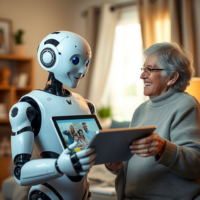Introduction
In an increasingly connected yet often isolated world, loneliness has emerged as a global epidemic. The rise of technology, while fostering convenience and efficiency, has also contributed to feelings of disconnection among individuals. From seniors living alone to young professionals struggling with mental health challenges, many people are searching for meaningful emotional support. In response, companies across the globe are developing innovative solutions—robots designed not just for functionality but for companionship.
This blog explores how robotic technology is being leveraged to combat loneliness, offering emotional support in ways that were once thought impossible. We’ll delve into the science behind these advancements, examine real-world applications, and discuss the ethical considerations surrounding this growing trend.
The Loneliness Epidemic: A Growing Concern
Loneliness is more than just a fleeting emotion; it’s a chronic condition affecting millions worldwide. Studies have shown that prolonged loneliness can lead to serious physical and mental health issues, including depression, anxiety, cardiovascular disease, and even premature death. According to a report by the American Psychological Association (APA), nearly 40% of adults in the U.S. feel lonely, with similar trends observed globally.
While traditional methods such as therapy, social groups, and community programs offer some relief, they aren’t always accessible or effective for everyone. Enter robots—a cutting-edge solution aimed at bridging the gap between humans and meaningful interaction.
How Robots Can Provide Emotional Support
Robots designed for emotional support go beyond basic tasks like cleaning or cooking. These advanced machines are equipped with artificial intelligence (AI) and machine learning capabilities, allowing them to engage in conversations, recognize emotions, and provide personalized care. Here’s how they work:
1. Social Interaction
Robots can simulate human-like interactions through speech recognition, natural language processing, and facial expressions. For example, Pepper, a humanoid robot developed by SoftBank Robotics, can hold simple conversations, tell jokes, and play games, making it an ideal companion for those who crave social engagement.
2. Emotional Recognition
Advanced AI algorithms enable robots to detect changes in tone, body language, and facial expressions, helping them respond appropriately to users’ moods. For instance, if someone appears sad, the robot might initiate a comforting conversation or suggest activities to lift their spirits.
3. Personalized Care
Some robots are tailored to meet specific needs, such as assisting elderly individuals with dementia or providing companionship to children with autism. PARO, a therapeutic robot seal, has been particularly successful in reducing stress and improving mood among seniors in nursing homes.
4. Constant Companionship
Unlike humans, robots don’t get tired or need breaks, ensuring constant availability for companionship. This reliability makes them especially valuable for people who live alone or have limited access to social networks.
Real-World Applications of Companion Robots
Several companies are already making waves in the field of emotional support robotics. Let’s take a closer look at some notable examples:
1. ElliQ by Intuition Robotics
ElliQ is a socially assistive robot designed specifically for older adults. It uses AI to encourage physical activity, cognitive stimulation, and digital connectivity. By suggesting activities like walking or video calls with family members, ElliQ helps seniors stay engaged and reduce feelings of isolation.
2. Jibo by Jibo Inc.
Jibo was one of the first consumer-friendly social robots, marketed as a “family assistant.” Though no longer in production, its legacy lives on as a pioneer in creating emotionally intelligent devices capable of storytelling, playing music, and engaging in casual conversations.
3. Lovot by Groove X
Lovot is a small, cuddly robot designed to evoke feelings of love and comfort. Its soft exterior and childlike movements make it appealing to both children and adults seeking affection. Equipped with sensors and cameras, Lovot responds to touch and voice commands, forming unique bonds with its owners.
4. Mabu by Catalia Health
Mabu is a healthcare-focused robot designed to support patients managing chronic illnesses. While primarily used for medication reminders and symptom tracking, Mabu also provides emotional encouragement, fostering a sense of partnership and trust.
Benefits of Emotional Support Robots
The integration of robots into daily life offers numerous benefits, particularly for vulnerable populations:
1. Improved Mental Health
By reducing feelings of loneliness and increasing opportunities for positive interactions, robots contribute to better mental well-being. Users report feeling happier and more fulfilled after spending time with their robotic companions.
2. Enhanced Independence
For seniors or individuals with disabilities, robots can help maintain independence by performing routine tasks while providing emotional support. This dual functionality promotes self-sufficiency and dignity.
3. Cost-Effective Solution
Compared to hiring full-time caregivers or therapists, investing in a robot may prove more cost-effective over time. Additionally, robots eliminate concerns about scheduling conflicts or inconsistent service quality.
4. Scalability
Robots can be mass-produced and deployed globally, reaching underserved communities where human resources may be scarce. This scalability ensures that emotional support is available to anyone who needs it.
Challenges and Ethical Considerations
Despite their potential, emotional support robots raise important questions about ethics, privacy, and human relationships:
1. Dependency on Technology
There’s a risk that people could become overly reliant on robots, further distancing themselves from human connections. Striking a balance between technological assistance and genuine interpersonal relationships will be crucial moving forward.
2. Privacy Concerns
Many robots collect data on user behavior, preferences, and habits. Ensuring robust security measures to protect sensitive information is essential to maintaining public trust.
3. Authenticity of Connection
Critics argue that interactions with robots lack authenticity compared to those with humans. Developers must address this concern by refining AI systems to create more nuanced and relatable experiences.
4. Accessibility
Not everyone can afford high-end robotic companions, potentially exacerbating existing inequalities. Policymakers and manufacturers should prioritize affordability and inclusivity when designing and distributing these technologies.
The Future of Emotional Support Robotics
As AI continues to evolve, so too will the capabilities of emotional support robots. Future innovations may include:
- Improved Natural Language Processing: Enabling robots to understand complex emotions and respond with greater empathy.
- Customizable Avatars: Allowing users to personalize the appearance and personality of their robotic companions.
- Integration with Wearables: Combining robots with wearable tech to monitor health metrics and tailor responses accordingly.
- Cross-Cultural Adaptation: Designing robots that cater to diverse cultural norms and values, ensuring universal appeal.
Conclusion
The development of emotional support robots represents a significant step forward in addressing the loneliness epidemic. By combining advanced technology with compassionate design, companies are creating solutions that enhance the lives of countless individuals. However, as we embrace this new era of human-robot interaction, it’s vital to approach it responsibly, prioritizing ethics, inclusivity, and genuine connection.
Ultimately, while robots cannot replace the depth of human relationships, they can serve as valuable supplements, offering comfort, companionship, and care to those who need it most. As society continues to grapple with the complexities of modern life, these innovative tools remind us that even in solitude, there’s hope for connection—and perhaps even joy.

